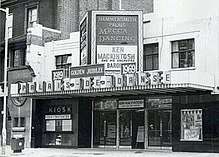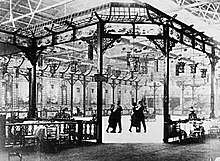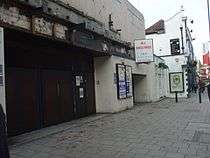Hammersmith Palais
| "The Palais" | |
 Exterior sign used from 2003 to 2007. | |
 The Hammersmith Palais in 1969, when it was celebrating its golden jubilee. | |
| Former names | Hammersmith Palais de Danse |
|---|---|
| Address |
242 Shepherd's Bush Road London W6 7NL United Kingdom |
| Coordinates | 51°29′39″N 0°13′27″W / 51.494052°N 0.224087°WCoordinates: 51°29′39″N 0°13′27″W / 51.494052°N 0.224087°W |
| Owner |
Howard Booker and Frank Mitchell (1919–) Mecca Leisure Group (1960–1990) Rank Group (1990–1999) Po Na Na Group (1999–2003) Barvest (2003–2006) Parkway Properties (2006–2012) |
| Type | Dance hall, music venue, nightclub |
| Genre(s) | Entertainment |
| Capacity | 2,500[1] |
| Opened | 28 November 1919 |
| Closed | April 2007 |
| Years active | 87 |
The Hammersmith Palais de Danse, in its last years simply named Hammersmith Palais, was a dance hall and entertainment venue in Hammersmith, London, England that operated from 1919 until 2007. It was the first palais de danse [nb 1] to be built in Britain.[3][4] In 2009, it was named by the Brecon Jazz Festival as one of twelve venues which had made the most important contributions to jazz music in the United Kingdom.[5]
The Palais occupied a large site on the A219 at 242 Shepherd's Bush Road, London W6, near the circular system under the A4 Hammersmith flyover. The area has two London Underground stations, a bus station, and the road network at Hammersmith Broadway.[3]
History

Built in 1910 on a site formerly occupied by a tram shed[3] for London United Tramways, the Brook Green Roller Skating Rink,[1] which had been closed since 1915,[nb 2] was acquired at the end of the First World War by North American entrepreneurs Howard Booker and Frank Mitchell,[3][4] to convert it into a place to host ballroom dancing and various kinds of dance bands, among which were the new jazz bands. The first incarnation of the Palais was the work of architect Bertie Crewe.[1] Its Chinese-style decoration featured lacquered columns, fretwork and a pagoda roof with silk lanterns.[1][3] In the centre of the expensive sprung dance floor,[3] made of Canadian maple,[1] was a model mountain with a replica Chinese village and a fountain.[3] At each end thereof, was a low-rise bandstand encased in glass, to allow two bands to play alternate numbers for the dancers.[3][6][7] The venue, which also featured a restaurant and a café,[3] was considered at the time to be the largest and most luxurious establishment of its kind in Europe.[1] The Hammersmith Palais de Danse opening night took place on 28 November 1919.[6][7] Nick LaRocca's Original Dixieland Jazz Band, on tour from America, played regularly at the Palais from that night until June 1920.[8][9][10] Many of the famous jazz stars of the day would appear in concert there, including American jazz singer Adelaide Hall, who performed at the venue during the week from 27 March to 2 April 1939, accompanied by Fela Sowande and his Florida Club Orchestra.[11]
During the Great Depression, while dance halls saw a reduction in attendance, ice skating, instead, came into fashion and replaced dancing as the most popular leisure activity.[12] As a result, the Palais site was converted into an ice rink,[1][13] which was opened on 30 December 1929, with the original London Lions ice hockey team using it as a base. However, this skate craze proved short-lived,[13] and by late 1934 the rink was reverted to a dance hall.[1] A new maple dance floor at a cost of £5,000 was installed in the venue.[14]

In 1959, Joe Loss and his Orchestra, with singers Rose Brennan, Ross MacManus and Larry Gretton, became the resident dance band at the Palais.[15] For the next decade, they were a regular feature every night, except on Monday's "Record Night" when only recorded music was played and no alcohol was served from the bar.[nb 3] In 1960, the Mecca organisation acquired the Palais.[15] Other house bands during the 1960s and 1970s included Andy Ross, Ken Mackintosh,[17] Tony Evans, and Zodiac.[18] On many Saturday nights, in excess of 2,000 people would visit the venue. One of the features was a huge revolving stage with a band on each side (this also caused a number of accidents when microphones and stands were left on the revolve).
The Hammersmith Palais remained a popular dance venue from its start to the late 1980s, from then on hosting mainly live music gigs, but also dance nights and private events.[19] The venue accommodated the popular School-Disco club night, which subsequently moved to the London Forum in Kentish Town. Promoters Onyx Promotions championed Brit-Asian bands and DJs including: DCS, Heera, Juggy D, Panjabi Hit Squad, Premi, RDB, Rishi Rich and Xzecutive/San-j Sanj. The Students' Union at Imperial College School of Medicine frequently hired the Palais as a venue for student nights.
The Palais played host to countless artists; among them: Bill Haley & His Comets (1974), the Beatles, the Rolling Stones, the Who, David Bowie, the Sex Pistols, Elvis Costello and the Attractions, the Cure, the Police, U2, the Jesus and Mary Chain, Robert Plant & the Strange Sensation, Hanoi Rocks, and Kylie Minogue. Bands such as PiL, the Cramps and Soft Cell, who played their "farewell" concerts there in January 1984, made the venue popular for London gig-goers.
From 1999 to 2003, the Palais was owned by the Po Na Na Group, which converted it into a themed nightclub called Po Na Na Hammersmith.[15]
Closure and demolition

On 20 March 2007, despite its importance to Britain's cultural history,[19] the Hammersmith Palais was condemned for demolition.[15][20][21] Among the artists playing the last concerts at the venue were Kasabian, Idlewild, and Jamie T. On 31 March 2007, the unnamed Damon Albarn-fronted band informally known as the Good, the Bad & the Queen did a show which was previously promoted as the official send-off for the legendary place.[22][23] However, the last ever gig at the Palais, scheduled before it was known that the building was to be sold, was a performance by Mark E. Smith's the Fall on 1 April 2007;[24] a recording and a film of which was subsequently released as the live album Last Night at The Palais.[25]
Whilst The Fall was intended to be the last night of The Hammersmith Palais, there was one more gig that took place on May 3rd 2007 by Groove Armada to launch their new album Soundboy Rock. Firmly giving them the honour of the last band ever to play live at the Hammersmith Palais.

Film producer and director Richard Weller made a documentary for BBC Television about the venue's history, titled Last Man at the Palais.[26] It was first screened on BBC Four on Christmas Eve 2007.[27] Near the end of the film, ballroom dancer Lyndon Wainwright performs "The Last Waltz" on the dance floor of the Palais.[26]
Following its closure as a music venue, proposals for the site included use as an office and restaurant complex, or a students' hall of residence. Hammersmith and Fulham London Borough Council had been expected to rule on the proposed demolition and development in November 2009;[23][28] however, on 27 October 2009, the council rejected plans to turn the Hammersmith Palais site into student flats.[nb 4]
In July 2010, the Planning Inspectorate held a week-long public inquiry and rejected an appeal by a development company against a council decision to block a proposed development. The developers were London & Regional (Hammersmith), who were given leave to submit an amended application.[30][31]
The Palais was finally demolished in May 2012.[19][32] A new building was constructed on the site, and in September 2013 opened as a luxury student hall of residence, advertised as being on the site of the Hammersmith Palais.[33]
In popular culture
Michael Monroe's 1993–1994 band Demolition 23 recorded a track called "Hammersmith Palais" on their 1994 self-titled album. The song, a nostalgic description of the 1980s club scene in London, was written by Monroe, Jude Wilder and Little Steven (Steven Van Zandt).
The venue provides inspiration for the Dan Wilde track "Hammersmith Palais", from his 2016 album "Rhythm on the City Wall".
The venue is named in several songs, including:
- The Emerson, Lake & Palmer song "Benny the Bouncer", from their 1973 album Brain Salad Surgery.[34]
- The Clash song "(White Man) In Hammersmith Palais";[15][32][35] Joe Strummer managed to get thrown out one Thursday afternoon for gaining entry without permission.
- The Ian Dury and the Blockheads song "Reasons to be Cheerful, Part 3".[36]
- The Elvis Costello and the Attractions song "London's Brilliant Parade", from their 1994 album Brutal Youth; Costello would frequently visit the Palais as a youth, watching from the balcony his father Ross MacManus perform with the Joe Loss Orchestra.[37][38]
Notes
- ↑ Palais de danse is a lexical borrowing from French, meaning "dance palace", that refers to purpose-built commercial dance halls which appeared on Britain's high streets from the 1920s onwards.[2]
- ↑ "Advertisements for the rink continue to appear in the local newspapers until 1915, after which the building may have been devoted to wartime purposes."[1]
- ↑ The term discothèque, coined in the early 1940s in German-occupied France, was already current in English in the 1950s.[16]
- ↑ The full history of planning applications for the site can be found at the official website of the London Borough of Hammersmith and Fulham.[29]
References
- 1 2 3 4 5 6 7 8 9 Kimber & Hammersmith and Fulham Archives and Local History Centre 2008, p. 7.
- ↑ Nott 2015, p. 3.
- 1 2 3 4 5 6 7 8 9 Nott 2015, p. 18.
- 1 2 Rust 1969, p. 86.
- ↑ London Evening Standard (3 August 2009). "Buckingham Palace Hits Right Note with Jazz Fans". London Evening Standard. Retrieved 11 May 2016
- 1 2 Edwards 1950, p. 11.
- 1 2 Walker 1983, p. 108.
- ↑ Kimber & Hammersmith and Fulham Archives and Local History Centre 2008, p. 7-8.
- ↑ Nott 2015, p. 19.
- ↑ Walker 1983, p. 109.
- ↑ Sadoh 2007, p. 97.
- ↑ Nott 2015, p. 23-24.
- 1 2 Nott 2015, p. 24.
- ↑ Nott 2015, p. 30.
- 1 2 3 4 5 Kimber & Hammersmith and Fulham Archives and Local History Centre 2008, p. 8.
- ↑ Hilton, Denny (19 October 2012). "The birth of disco". Oxford University Press Blog. Retrieved 7 January 2017.
- ↑ "Ken Mackintosh: Swinging big band-leader" (obituary). The Independent (1 December 2005). Retrieved 20 July 2017.
- ↑ Zodiac, Function Band and Orchestra.
- 1 2 3 Nott 2015, p. 94.
- ↑ Hammersmith and Fulham London Borough Council (20 March 2007). Decision on the application for demolition permit of the Hammersmith Palais. London Borough of Hammersmith and Fulham. Retrieved 15 May 2016.
- ↑ The Fall (2009), Last Night at The Palais. Sanctuary Records. cat. #2713432. Liner notes.
- ↑ Barnes, Anthony (4 March 2007). "The last white man in Hammersmith Palais". The Independent. Archived from the original on 22 March 2007.
- 1 2 Connor, Alan (30 March 2007). "White man's blues". Smashed Hits. BBC News Online. Archived from the original on 21 October 2017. Retrieved 14 February 2018.
- ↑ "The Fall close Hammersmith Palais". New Musical Express (1 December 2005). Retrieved 14 February 2018.
- ↑ The Fall (1 April 2007). Last Night at The Palais (concert film). Sanctuary Records. Online at YouTube (part 1/6). Retrieved 16 October 2016.
- 1 2 Weller 2009, p. 7.
- ↑ "Last Man in Hammersmith Palais". BBC Four (TV channel). 2007. Archived from the original on 6 September 2014.
- ↑ Bloomfield, Ruth (10 September 2009). "Hammersmith Palais is set to be turned into student flats". London Evening Standard. Archived from the original on 6 September 2014.
- ↑ Hammersmith and Fulham London Borough Council. Property History: 000034027971 | Hammersmith Palais 242 Shepherd's Bush Road London W6 7NL. London Borough of Hammersmith and Fulham. Retrieved 15 May 2016.
- ↑ "Hammersmith Palais demolition appeal turned down". Get West London. 6 August 2010. Archived from the original on 7 September 2014.
- ↑ "Developer loses Palais appeal". H&F News. 27 July 2010. Archived from the original on 7 September 2014.
- 1 2 Haslam, Dave (29 August 2015). "Boogie Wonderlands: Five of the Most Influential Nightclubs of the Last 100 Years". The Guardian. Retrieved 10 May 2016.
- ↑ "Pure Hammersmith – London". Pure Student Living. Archived from the original on 7 September 2014. Retrieved 7 September 2014.
- ↑ Emerson, Lake & Palmer, "Benny the Bouncer", lyrics. MetroLyrics. Retrieved 7 January 2017.
- ↑ The Clash, "(White Man) In Hammersmith Palais", lyrics. MetroLyrics. Retrieved 3 July 2017.
- ↑ Ian Dury and the Blockheads, "Reasons to be Cheerful, Part 3", lyrics. MetroLyrics. Retrieved 3 July 2017.
- ↑ https://www.theguardian.com/music/2011/dec/21/ross-macmanus
- ↑ .
Works cited
- Edwards, Tom (May 1950). "Jazz Band Ball: New Orleans to Hammersmith". Jazz Illustrated. Vol. 1 no. 6. London, United Kingdom: Wilcox Organisation. pp. 10–11. OCLC 173860453.
- Kimber, Jane; Hammersmith and Fulham Archives and Local History Centre (Autumn 2008). "'Danse' to the Music of Time" (PDF). Hammersmith and Fulham Historic Buildings Group Newsletter. No. 19. pp. 7–8. Retrieved 7 July 2017.
- Nott, James (2015). Going to the Palais: A Social and Cultural History of Dancing and Dance Halls in Britain, 1918–1960. Oxford, United Kingdom: Oxford University Press. ISBN 9780199605194.
- Rust, Frances (1969). Dance in Society: An Analysis of the Relationship between the Social Dance and Society in England from the Middle Ages to the Present Day. The International Library of Sociology (85). London, United Kingdom: Routledge & Kegan Paul. ISBN 9780710065827.
- Sadoh, Godwin (2007). The Organ Works of Fela Sowande: Cultural Perspectives. Lincoln, Nebraska: iUniverse. ISBN 9780595473175.
- Walker, Edward S. (February–March 1983). "Saturday Night at the Palais -'21". Storyville. No. 105. Chigwell, United Kingdom. pp. 108–109. ISSN 0039-2030.
- Weller, Richard (Spring 2009). "Project Palais" (PDF). Hammersmith and Fulham Historic Buildings Group Newsletter. No. 20. p. 7. Retrieved 11 July 2017.
Further reading
- Haslam, Dave (2015). Life After Dark: A History of British Nightclubs and Music Venues. New York City: Simon & Schuster. ISBN 9780857206985.
Other media
- Dixon, Terence (1973). May I Have the Pleasure?: A Profile of Hammersmith Palais (TV documentary miniseries). Thames Television.
- Weller, Richard (2007). Last Man in Hammersmith Palais (TV documentary). BBC Four.
External links
- Hammersmith Palais discography at Discogs.
Articles
- Haslam, Dave (29 August 2015). "Boogie Wonderlands: Five of the Most Influential Nightclubs of the Last 100 Years". The Guardian.
Videos
- The Fall Last Night At The Palais Live 2007 (concert film, part 1/6). YouTube.
Images
- Hammersmith and Fulham London Borough Council (10 March 2008). Photographic record of the Hammersmith Palais. London Borough of Hammersmith and Fulham.
- GES019 (June 2010). "GES019 – Hammersmith Palais Theatre" (photo gallery). Guerrilla Exploring.
- De-Keyzer, Amy; WLON (26 February 2015). "History of Hammersmith Palais" (photo gallery). Get West London.